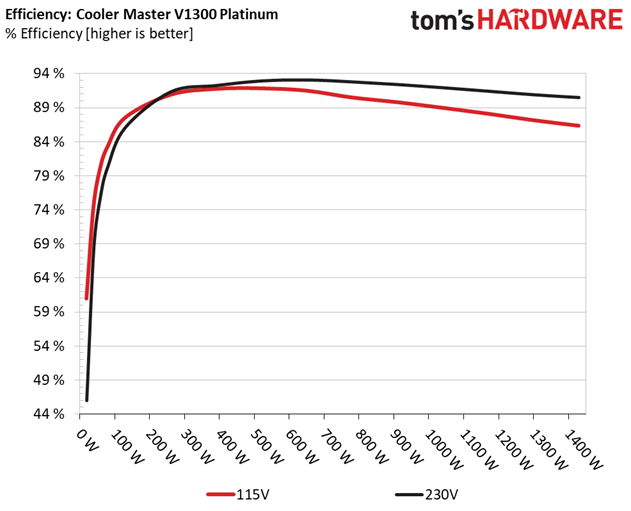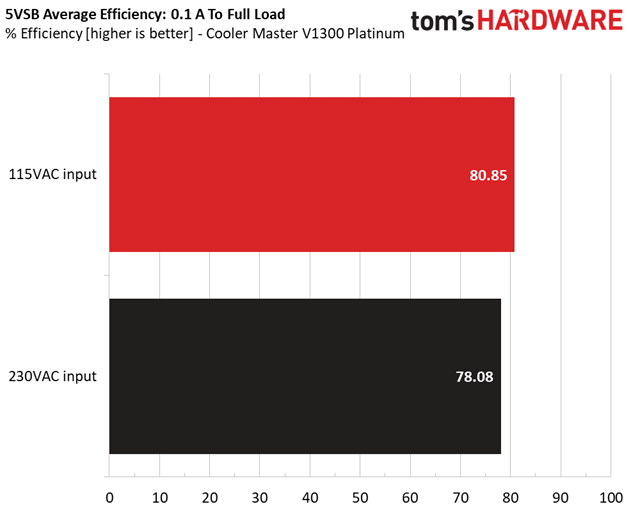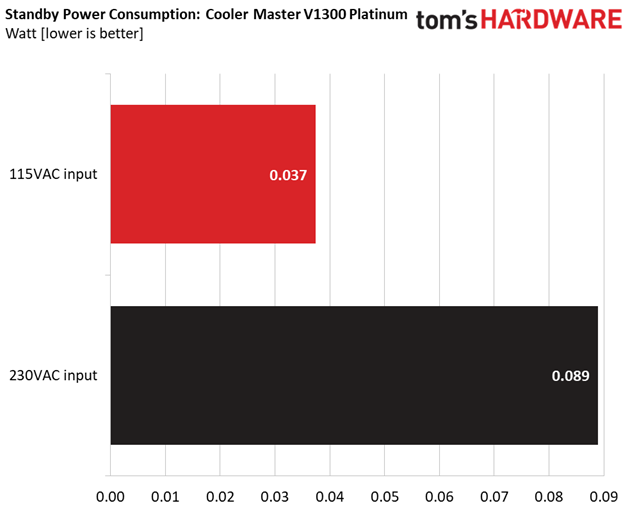Cooler Master V1300 Platinum Power Supply Review: Plenty of Juice
Why you can trust Tom's Hardware
Load Regulation, Hold-Up Time, Inrush Current, Efficiency and Noise
To learn more about our PSU tests and methodology, please check out How We Test Power Supply Units.
Primary Rails And 5VSB Load Regulation
The following charts show the main rails' voltage values recorded between a range of 40W up to the PSU's maximum specified load, along with the deviation (in percent). Tight regulation is an important consideration every time we review a power supply, because it facilitates constant voltage levels despite varying loads. Tight load regulation also, among other factors, improves the system’s stability, especially under overclocked conditions and, at the same time, it applies less stress to the DC-DC converters that many system components utilize.








Hold-Up Time
Put simply, hold-up time is the amount of time that the system can continue to run without shutting down or rebooting during a power interruption.







The hold-up time is long enough, given the PSU's enormous capacity, and the power ok signal is accurate.
Inrush Current
Inrush current, or switch-on surge, refers to the maximum, instantaneous input current drawn by an electrical device when it is first turned on. A large enough inrush current can cause circuit breakers and fuses to trip. It can also damage switches, relays, and bridge rectifiers. As a result, the lower the inrush current of a PSU right as it is turned on, the better.


The inrush current is low enough with 115V. It is notably higher with 230V though, but not at dangerously high levels.
10-110% Load Tests
These tests reveal the V1300’s load regulation and efficiency levels under high ambient temperatures. They also show how the fan speed profile behaves under increased operating temperatures.
Get Tom's Hardware's best news and in-depth reviews, straight to your inbox.
| Test # | 12V | 5V | 3.3V | 5VSB | DC/AC (Watts) | Efficiency | Fan Speed (RPM) | PSU Noise (dB[A]) | Temps (In/Out) | PF/AC Volts |
|---|---|---|---|---|---|---|---|---|---|---|
| 1 | 8.908A | 2.007A | 1.970A | 0.990A | 129.708 | 87.479% | 648 | 15.1 | 39.78°C | 0.966 |
| 12.135V | 4.987V | 3.351V | 5.050V | 148.274 | 43.72°C | 115.13V | ||||
| 2 | 18.887A | 3.011A | 2.957A | 1.192A | 259.813 | 90.858% | 648 | 15.1 | 40.97°C | 0.958 |
| 12.120V | 4.983V | 3.347V | 5.035V | 285.956 | 45.19°C | 115.13V | ||||
| 3 | 29.223A | 3.515A | 3.438A | 1.395A | 389.719 | 91.724% | 647 | 15.1 | 41.31°C | 0.972 |
| 12.104V | 4.980V | 3.344V | 5.020V | 424.884 | 47.31°C | 115.12V | ||||
| 4 | 39.586A | 4.020A | 3.950A | 1.599A | 519.726 | 91.808% | 649 | 15.1 | 41.72°C | 0.979 |
| 12.088V | 4.978V | 3.341V | 5.005V | 566.104 | 49.52°C | 115.12V | ||||
| 5 | 49.649A | 5.028A | 4.943A | 1.804A | 649.871 | 91.466% | 647 | 15.1 | 42.32°C | 0.984 |
| 12.072V | 4.974V | 3.338V | 4.989V | 710.507 | 51.06°C | 115.12V | ||||
| 6 | 59.663A | 6.036A | 5.937A | 2.011A | 779.998 | 90.468% | 882 | 24.1 | 43.06°C | 0.987 |
| 12.071V | 4.971V | 3.335V | 4.973V | 862.177 | 52.88°C | 115.11V | ||||
| 7 | 69.760A | 7.048A | 6.934A | 2.220A | 910.080 | 89.777% | 1201 | 32.4 | 43.84°C | 0.989 |
| 12.055V | 4.968V | 3.332V | 4.957V | 1013.709 | 54.29°C | 115.11V | ||||
| 8 | 79.903A | 8.060A | 7.932A | 2.430A | 1040.203 | 88.947% | 1633 | 39.7 | 44.17°C | 0.990 |
| 12.037V | 4.964V | 3.328V | 4.940V | 1169.466 | 55.30°C | 115.11V | ||||
| 9 | 90.483A | 8.569A | 8.423A | 2.434A | 1169.950 | 88.083% | 2187 | 47.2 | 45.44°C | 0.992 |
| 12.018V | 4.961V | 3.325V | 4.933V | 1328.240 | 57.30°C | 115.10V | ||||
| 10 | 100.852A | 9.079A | 8.942A | 3.063A | 1299.948 | 87.135% | 2186 | 47.2 | 45.86°C | 0.992 |
| 12.000V | 4.958V | 3.322V | 4.899V | 1491.877 | 58.39°C | 115.10V | ||||
| 11 | 111.817A | 9.082A | 8.948A | 3.066A | 1429.727 | 86.322% | 2188 | 47.2 | 46.97°C | 0.993 |
| 11.984V | 4.956V | 3.319V | 4.893V | 1656.272 | 59.90°C | 115.09V | ||||
| CL1 | 0.139A | 16.004A | 15.999A | 0.000A | 134.695 | 82.860% | 647 | 15.1 | 42.33°C | 0.966 |
| 12.134V | 4.969V | 3.343V | 5.081V | 162.557 | 51.05°C | 115.12V | ||||
| CL2 | 107.994A | 1.002A | 1.002A | 1.000A | 1309.775 | 87.479% | 2185 | 47.2 | 45.52°C | 0.993 |
| 12.005V | 4.971V | 3.328V | 4.992V | 1497.248 | 57.87°C | 115.09V |
With 20% load, the unit meets the 80 PLUS Platinum requirement of 90% efficiency, but it falls short with 50% and 100% load. Especially with full load it is far away from the required 89%. Nonetheless, 80 PLUS conducts its tests in much lower temperatures so it is natural to measure higher efficiency. However 23 degrees Celsius (+-5 degrees Celsius), the ambient that 80 PLUS uses for its testing, are highly unrealistic even for chassis with good airflow.
20-80W Load Tests
In the following tests, we measure the V1300's efficiency at loads significantly lower than 10% of its maximum capacity (the lowest load the 80 PLUS standard measures). This is important for representing when a PC is idle, with power-saving features turned on.
| Test # | 12V | 5V | 3.3V | 5VSB | DC/AC (Watts) | Efficiency | Fan Speed (RPM) | PSU Noise (dB[A]) | PF/AC Volts |
|---|---|---|---|---|---|---|---|---|---|
| 1 | 1.195A | 0.503A | 0.478A | 0.197A | 19.630 | 60.965% | 648 | 15.1 | 0.759 |
| 12.147V | 4.990V | 3.352V | 5.088V | 32.199 | 115.15V | ||||
| 2 | 2.450A | 1.004A | 0.985A | 0.394A | 40.068 | 74.588% | 648 | 15.1 | 0.876 |
| 12.145V | 4.990V | 3.352V | 5.079V | 53.719 | 115.15V | ||||
| 3 | 3.632A | 1.504A | 1.463A | 0.592A | 59.512 | 80.219% | 648 | 15.1 | 0.914 |
| 12.143V | 4.989V | 3.352V | 5.070V | 74.187 | 115.15V | ||||
| 4 | 4.889A | 2.007A | 1.967A | 0.790A | 79.960 | 83.239% | 648 | 15.1 | 0.939 |
| 12.141V | 4.988V | 3.352V | 5.061V | 96.061 | 115.13V |
The efficiency levels are low, at light loads.
Efficiency
Next, we plotted a chart showing the V1300’s efficiency at low loads, and loads from 10 to 110% of its maximum-rated capacity. The higher a PSU’s efficiency, the less energy goes wasted leading to a reduced carbon footprint and lower electricity bills.




The V1300 is close enough to the competition with normal loads. Under light loads, there are 1200W units with notably higher efficiency levels (but there are also some with lower).
5VSB Efficiency
| Test # | 5VSB | DC/AC (Watts) | Efficiency | PF/AC Volts |
|---|---|---|---|---|
| 1 | 0.100A | 0.509 | 79.407% | 0.043 |
| 5.093V | 0.641 | 115.09V | ||
| 2 | 0.250A | 1.272 | 82.330% | 0.099 |
| 5.088V | 1.545 | 115.08V | ||
| 3 | 0.550A | 2.792 | 82.996% | 0.195 |
| 5.075V | 3.364 | 115.08V | ||
| 4 | 1.000A | 5.057 | 82.888% | 0.298 |
| 5.057V | 6.101 | 115.09V | ||
| 5 | 1.500A | 7.557 | 82.266% | 0.369 |
| 5.037V | 9.186 | 115.10V | ||
| 6 | 3.000A | 14.939 | 78.784% | 0.469 |
| 4.980V | 18.962 | 115.10V |


The 5VSB rail achieves sky-high efficiency levels!
Power Consumption In Idle And Standby
| Mode | 12V | 5V | 3.3V | 5VSB | Watts | PF/AC Volts |
|---|---|---|---|---|---|---|
| Idle | 12.141V | 4.991V | 3.353V | 5.095V | 11.626 | 0.443 |
| 115.1V | ||||||
| Standby | 0.037 | 0.002 | ||||
| 115.1V |


Fan RPM, Delta Temperature, And Output Noise
All results are obtained between an ambient temperature of 37 to 47 degrees Celsius (98.6 to 116.6 degrees Fahrenheit).
The fan profile is smooth enough, since it gradually increases the fan's speed according to the load and the operating temperature.
The following results were obtained at 30 to 32 degrees Celsius (86 to 89.6 degrees Fahrenheit) ambient temperature.
With up to 750W loads the fan spins at its lowest speed, keeping the noise output low. It takes more than 1050W for the PSU to enter the 35-40 dB(A) range (comparative noise example: library) and with higher than 1140W loads you will expose your ears to >40 dB(A).
MORE: Best Power Supplies
MORE: How We Test Power Supplies
MORE: All Power Supply Content
Current page: Load Regulation, Hold-Up Time, Inrush Current, Efficiency and Noise
Prev Page Specifications and Part Analysis Next Page Protection Features, DC Power Sequencing, Cross-Load Tests and Infrared Images
Aris Mpitziopoulos is a contributing editor at Tom's Hardware, covering PSUs.






